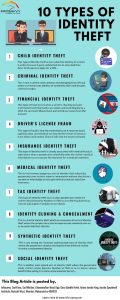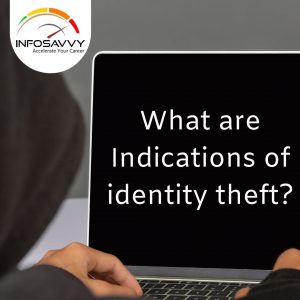10 Types of Identity Theft You Should Know About
Identity Theft is an article to learn about This & its types, Indication with different types of techniques which is used by attackers etc.
What is identity theft?
Identity theft could be a problem that several consumers face today. Within the us, some state legislators have imposed laws restricting employees from providing their SSNs (Social Security Numbers) during their recruitment. Identity theft frequently figures in news reports. Companies should learn about identity theft, so they do not endanger their own anti-fraud initiatives.
This section discusses identity theft, identity theft statistics, techniques for obtaining personal information for fraud and therefore the various steps involved in stealing an identity.
The fraud and Assumption Deterrence Act of 1998 define identity theft as the illegal use of someone’s identification. Identity theft occurs when someone steals others personally identifiable information for fraudulent purposes. Attackers illegally obtain personally identifying information to commit fraud or other criminal acts. Learn more about identity theft in CEH from Infosavvy.
This section discusses identity theft, identity theft statistics, techniques for obtaining personal information for fraud and therefore the various steps involved in stealing an identity.
The fraud and Assumption Deterrence Act of 1998 define identity theft as the illegal use of someone’s identification. Identity theft occurs when someone steals others personally identifiable information for fraudulent purposes. Attackers illegally obtain personally identifying information to commit fraud or other criminal acts. Learn more about identity theft in CEH from Infosavvy.
“The more quickly you detect Identity Theft, The Easier It is to Recover”
Types of personally identifiable information stolen by identity thieves:

Attacker steals people’s identity for fraudulent purposes such as:
– Opening a brand new credit card accounts within the name of the user without paying the bills
– Opening a new phone or wireless account in the user’s name, or running up charges on his/her existing account- Using victims’ information to get utility services like electricity, heating, or cable TV
– Opening bank accounts for writing bogus checks using victims’ information
– Cloning an ATM or open-end credit to form electronic withdrawals from victims’ accounts
Obtaining loans those victims are liable
– Obtaining driving licenses, passport, or other official ID cards that contain victims’ data but attackers’ photos
Using victims’ names and social security numbers to receive their government benefits
– Impersonating employees of a target organization to physically access its facility
– Taking over insurance policies- Selling personal information
– Ordering goods online employing a drop-site
– Hijacking email accounts
– Obtaining health services
– Submitting fraudulent tax returns
– Committing other crimes, then providing victims’ names to the authorities during their arrest, rather than their own
– Opening a new phone or wireless account in the user’s name, or running up charges on his/her existing account- Using victims’ information to get utility services like electricity, heating, or cable TV
– Opening bank accounts for writing bogus checks using victims’ information
– Cloning an ATM or open-end credit to form electronic withdrawals from victims’ accounts
Obtaining loans those victims are liable
– Obtaining driving licenses, passport, or other official ID cards that contain victims’ data but attackers’ photos
Using victims’ names and social security numbers to receive their government benefits
– Impersonating employees of a target organization to physically access its facility
– Taking over insurance policies- Selling personal information
– Ordering goods online employing a drop-site
– Hijacking email accounts
– Obtaining health services
– Submitting fraudulent tax returns
– Committing other crimes, then providing victims’ names to the authorities during their arrest, rather than their own
What are the types of identity theft?
Identity theft is consistently increasing and the identity thieves are finding new ways or techniques to steal different sort of target’s information. a number of the identity theft types are as follow:

Child identity theft:- This type of identity theft occurs when the identity of a minor is stolen because it goes undetected for an extended time. After birth, parents apply for a SSN or Social Security Number of their child which along with a special date of birth is used by identity thieves to use for credit accounts, loans or utility services, or to rent an area to measure and apply for state benefits.
Criminal identity theft:- This is one in all the most common and damaging kind of fraud where a criminal uses identity of somebody else’s and escapes criminal charges. When he’s caught or arrested, he provides the fake identity. The simplest way of protection against criminal fraud is to stay your personal information secure that has following safe Internet practices and being cautious of “shoulder surfers”.
Financial identity theft:- This type of fraud occurs when a victim’s checking account and MasterCard information are stolen and used illegally by a thief. He can reach MasterCard and withdraw money from the account or he can use the stolen identity to open a replacement account, get new credit cards and take loans. The knowledge that’s required to hack into the victim’s account and steal his information is obtained by the thieves through viruses, phishing attacks or data breaches.
Driver’s License fraud:- This type of fraud is that the easiest because it requires touch sophistication. an individual can lose his/her driver’s license or it are often easily stolen. Once it falls into the incorrect hands, the perpetrator can sell the driver’s license or misuse the fake driver license by committing traffic violations, of which victim is unaware of and fails to pay fine, and find you in having his license suspended or revoked.
Insurance identity theft:- This type of identity theft is closely associated with medical fraud; it takes place when a perpetrator unlawfully takes the victim’s medical information so as to access his insurance for a medical treatment. Its effects include difficulties in settling medical bills, higher insurance premiums and doubtless trouble in acquiring medical coverage afterward.
Medical identity theft:- This is the foremost dangerous sort of identity theft where the perpetrator uses victim’s name or information without the victim’s consent or knowledge so as to get medical products and claim insurance or healthcare services. Medical fraud leads to frequent erroneous entries within the victim’s medical records, which could lead on to false diagnosis and life-threatening decisions by the doctors.
Tax identity theft:- This type of identity theft occurs when perpetrator steals the victim’s Social Security Number or SSN so as to file fraudulent tax returns and acquire fraudulent tax refunds. It creates difficulties for the victim in accessing the legitimate tax refunds and leads to a loss of funds. Phishing emails are one among the most ricks employed by the criminal to steals a target’s information, Therefore, protection from such fraud includes adoption of safe Internet practices.
Identity Cloning and Concealment:- This is a kind of identity theft which encompasses all sorts of identity theft where the perpetrators plan to impersonate somebody else so as to easily hide their identity. These perpetrators might be illegal immigrants or those hiding from creditors or just want to become “anonymous” thanks to another reasons.
Synthetic identity theft:- This is one among the foremost sophisticated sorts of identity theft where the perpetrator obtains information from different victims to make a replacement identity. Firstly, he steals a Social Security Number or SSN and uses it with a mixture of faux names, date of birth, address and other details required for creating new identity. The perpetrator uses this new identity to open new accounts, loans, credit cards, phones, other goods and services. Learn more about types of identity theft in CEH from infosavvy.
Social identity theft:- This is another most typical sort of identity theft where the perpetrator steals victim’s Social Security Number or SSN so as to derive various benefits like selling it to some undocumented person, use it to defraud the govt by getting a replacement checking account, loans, credit cards or for passport.
“If we don’t act now to safeguard our privacy, we could all become victims of identity Theft”
– Bill Nelson
What are different techniques attackers use to get personal information for identity theft?
Discussed below are some methods by which attackers steal targets’ identities, which successively allow them to commit fraud and other criminal activities.
Theft of wallets, computers, laptops, cell phones, backup media, and other sources of private information Physical theft is common. Attackers steal hardware from places like hotels and recreational places, like clubs, restaurants, parks, and beaches. Given adequate time, they will recover valuable data from these sources.
Theft of wallets, computers, laptops, cell phones, backup media, and other sources of private information Physical theft is common. Attackers steal hardware from places like hotels and recreational places, like clubs, restaurants, parks, and beaches. Given adequate time, they will recover valuable data from these sources.
Internet Searches:- Attackers can gather a substantial amount of sensitive information via legitimate websites, using search engines like Google, Bing, and Yahoo!
Social Engineering:- Social engineering is that the art of manipulating people into performing certain actions or divulging personal information, and accomplishing the task without using cracking methods.
Dumpster Diving and Shoulder Surfing:- Attackers rummage through household garbage and trash bins of a corporation, ATM centers, hotels, and other places to get personal and financial information for fraudulent purposes.
Criminals may find user information by glancing at documents, personal identification numbers (PINS) typed into an cash machine (ATM), or by overhearing conversations.
Phishing:- The “fraudster” may pretend to be from a financial organization or other reputable organization and send spar or pop-up messages to trick users into revealing their personal information.
Skimming:- Skimming refers to stealing credit/debit card numbers by using special storage devices called skimmers or wedges when processing the cardboard.
Pretexting:- Fraudsters may pose as executives from financial institutions, telephone companies, and so on, who believe “smooth talking” and win the trust of a private to reveal sensitive information.
Pharming:- Pharming also referred to as domain spoofing, is a complicated sort of phishing during which the attacker redirects the connection between the IP address and its target server. The attacker may use cache poisoning (modifying the web address thereto of a rogue address) to do so. When the users type within the Internet address, it redirects them to a rogue website that resembles the first website.
Hacking:- Attackers may compromise user systems and route information using listening devices like sniffers and scanners. They gain access to an abundance of knowledge, decrypt it (if necessary), and use it for identity theft.
Key loggers and Password Stealers (Malwares):- An attacker may infect the user’s computer with Trojans, viruses, and so on, and then collect the keyword strokes to steal passwords, user names, and other sensitive information of private, financial, or business importance.
Attackers can also use err ails to send fake forms like tax income Service (IRS) forms to collect information from the victims.
War driving:- Attackers look for unsecure Wi-Fi wireless networks in moving vehicles containing laptops, smartphones, or PDAs. Once they find unsecure networks, they access sensitive information stored in users’ devices on those networks.
Mail Theft and Rerouting:- Often, mailboxes contain bank documents (credit cards or account statements), administrative forms, and more. Criminals use this information to get MasterCard information, or to reroute the mail to a replacement address.
What are Indications of identity theft?
People don’t realize that they’re the victim of identity theft until they experience some unknown and unauthorized issues occurring thanks to their stolen identity. Therefore, it’s of paramount importance that folks should be careful for the warning signs for his or her identities that are compromised. Listed below are a number of signs showing you’re a victim of an identity theft?






Comments
Post a Comment